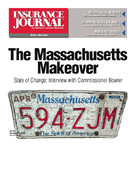One mutual insurance company merger works out like a dream, while another devolves into a nightmare. Why?
The dream mergers appear to take place when both partners are operating from positions of parity or strength and take the time to get to know one another’s operations and agents. The nightmares occur when one partner is in poor financial condition due to fraud or mismanagement.
When they work the way they should, mergers help mutuals grow their business, spread their risk, add experienced agents, improve their reinsurance, and boost surplus.
Farm mutual insurance company executives who have plowed the merger field shared these and other insights in a candid presentation titled, “The Good, the Bad and the Ugly” of company mergers at the 109th annual convention of the National Association of Mutual Insurance Companies (NAMIC) in Washington, D.C. in September. The NAMIC member executives shared what worked and what they would do differently with their fellow NAMIC members.
The good: surplus communication
Beverly Fick, manager of Bradford Victor Adams Mutual Insurance Co., of Franklin Grove, Ill., was the good news messenger on mergers. Her company, formerly known as Bradford Mutual, has gone through three mergers, including two at the same time.
In each of its mergers, Fick’s company strictly adhered to one maxim: The company was definitely “not interested” in merging with any company that would lower its surplus. There was no negotiation on that starting point. There was not going to be any Bradford marriage with a surplus-starved company.
Beyond that, Bradford executives talked a lot before acting. They took the time to get to know the target company and its people and agents, even when this meant four or five months of talks and comparing notes, meeting with agents, and showing up at policyholder meetings.
“Discussion kept the surprises to a minimum,” Fick said.
Leading up to the actual merger, her directors and managers focused on whether the company was internally prepared for a merger. Was it willing to change its name, its board of directors, its agency force? Were the staff and its automation capable of handling the transition and the new business?
The key communications were with agents, who had to be told that every policy would be re-underwritten and inspected, not always the way they were accustomed to doing business.
“It is important to build relationships with your new agents before the merger,” Fick emphasized in a question-answer period. “Be honest with them and do what you said you were going to do. Agents will receive the truth.”
All of the pre-merger talk paid off. Each of Bradford’s mergers went off without a hitch.
Only in some small issues would Fick do things differently. She would include the head underwriters in meetings with agents. She would obtain as many coverage codes and files as possible ahead of time. Other than that, it’s hard to find fault with the success her company has had managing its mergers.
The bad: job loss cost
Dave Poling, on the other hand, would change quite a few things about the way his company managed its merger. If he could do things differently, he might still have his job.
Poling’s company, Farmers Mutual Relief Association of Upper Sandusky, Ohio, hoped its three mergers with other farm insurers in its region would help spread its risk, which tended to be highly concentrated in just a few counties, and foster growth. In this and other ways, Poling’s merger was successful.
“Merging helped us spread the risk to half the state and achieve a much better mix,” he told NAMIC. Then, as hoped, the growth started to occur, averaging between 15 and 20 percent a year.
There were other benefits of the mergers, too. The larger company that emerged had an easier time getting reinsurance. Overhead expenses increased somewhat after the merger but as a percentage of premium, overhead declined.
Poling admits there were some glitches.
There were some “real problems” involving software compatibility in the mergers, he recalled. The one merger involving a company that had not automated at all was easier in this respect than the merger that required converting files and data from another system.
Underwriting and rating differences emerged. Poling advises any company to thoroughly investigate the actual rates of the one it is acquiring, looking beyond the manuals to the real rates and deviations in effect on policies. “It can be tough to get rates up to standard if the agents haven’t been used to that,” he added.
Looking back at his former job, Poling thinks a major mistake was not paying sufficient attention to the composition of the board of directors following the mergers. It ballooned to as many as 16 directors at one point before being reduced to 12.
“We ended up with too large a board of directors. It was too diverse and had too many different agendas. This worked against the company at times,” he said.
The mergers resulted in the addition of more than 50 new agents, a development that was positive for growth but that presented a threat to some existing in-house agents who feared their business and control would be eroded. This conflict ended up being the ultimate threat to Poling.
Despite annual growth of 15 to 20 percent, four agents on the board of directors who were “unhappy with the direction of the company” convinced “the other directors that we would lose business by underwriting and raising rates.” He was released from his CEO position as of Aug. 1, 2004. Poling’s hard-earned advice now? “For the board, avoid agent-directors and look for director-agents.” Also, keep the board small in size and have it put its directions in writing.
The ugly: doing the right thing
Despite that two of his company’s five mergers turned absolutely “ugly,” Charles Smith still has his job as general manager at Billings Mutual Insurance Co., in Billings, Mo.
“A merger can be a benefit to both companies and policyholders,” Smith stressed. But sometimes things can go wrong.
The mergers that got ugly involved companies that “had little or nothing to offer,” had ignored true underwriting and “basically were broke.”
“These become expensive and difficult mergers because every policy needs to be rewritten and employees need to be let go,” he said.
“Their pride or ego got in the way of them admitting their failure,” he said of the two troubled companies taken over by Billings Mutual.
In the “ugliest” case, his firm was asked to step in to protect policyholders by the state department of insurance after it found evidence of serious mismanagement and seriously weakened financials.
“Then the day before the policyholders’ meeting, it got even uglier,” recalled Smith. Auditors uncovered false claims, unpaid reinsurance, lower than reported surplus, misuse of a company credit card to pay off a trip to a fancy resort and, worst of all, a $1 million bank note that was never cited in the company’s earlier financial statements.
Things got so bad that state officials asked Billings to file charges against the former managers, but citing liability reasons, Billings declined, focusing instead on completing the deal “to serve the policyholders” and to protect the image of farm mutuals, he said.
The bottom line: put policyholders first
Heartland Mutual Insurance Co. Chief Executive Officer Bruce Thomas urged NAMIC executives to learn from the “ugly” tales and appreciate that mergers can be a positive experience.
Thomas, whose company is headquartered in Fort Dodge, Iowa, has gone through two mergers. It competed a merger with a company that could not find the reinsurance it needed on its own speedily, within two months. Another deal took three years of due diligence, management confabs, employee retreats and hard work to get it right.
“A merger is not for the benefit of the managers, directors or staff, but for the benefit of policyholders,” Thomas insisted.
The board of directors has to be strong and willing to look at the “big picture,” he added. A strong board is needed to avoid situations where a manager may have so much invested that he or she will proceed with a given merger even if it is not in the best interest of policyholders.
A merger can be the quickest way for farm mutuals to spread risk and grow, he said. Before one of its mergers, Heartland had 50 percent of its risk in one county, a figure that has been reduced to 28 percent post-merger.
“We had to improve the spread of risk and a merger was the answer,” Thomas said. His company has grown 10 percent a year the past three or fours years, whereas some mutuals have trouble growing. He cited the expanded and more diversified sales force of agents and the increased marketing opportunities that have come from mergers as a “tremendous advantage” for his company.
His company enjoys more rate stability, better reinsurance contracts and better relations with agents, Thomas reported. Overall, the effects of mergers are “mostly good” provided there is adequate planning.
Was this article valuable?
Here are more articles you may enjoy.


 Everton FC Buyer Accused of Fraud, Double-Pledging Assets in Lawsuit
Everton FC Buyer Accused of Fraud, Double-Pledging Assets in Lawsuit  Update: Fannie Mae Guidelines Raise Concerns, Could Bar ACV Coverage for Homes
Update: Fannie Mae Guidelines Raise Concerns, Could Bar ACV Coverage for Homes  Miami Retirement Fund Class Action Alleges Globe Life Officers Concealed Fraud
Miami Retirement Fund Class Action Alleges Globe Life Officers Concealed Fraud  Class Action Settlements Flooded With Fraudulent Claims by Scammers
Class Action Settlements Flooded With Fraudulent Claims by Scammers 


